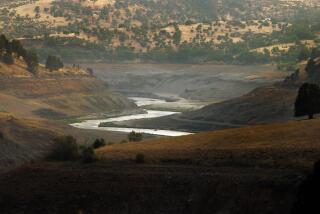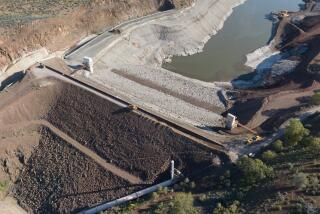Helmand dam a monument to U.S. challenges
- Share via
Reporting from Forward Operating Base Zeebrugge, — There may be no better symbol of American involvement in southern Afghanistan — initial success, current frustration and an uncertain future — than the giant Kajaki Dam.
Built in 1953 by the U.S. government, the 320-foot high, 887-foot-wide dam was part of a U.S. economic aid initiative in Helmand province that included irrigation canals, roads, schools, health clinics and more. The dam helped make the region the agricultural heartland of this sprawling country.
Helmand became known as “Little America” as hundreds of American teachers, engineers and medical professionals lived and worked in the provincial capital, Lashkar Gah, and in smaller villages and in neighboring Kandahar. A power station with two hydroelectric turbines were added in 1975.
But U.S. involvement in the province waned in the late 1970s and ended when the Soviet Union took invaded Afghanistan in 1979. Eventually Helmand and Kandahar became the spiritual home of the Taliban.
During the Soviet decade and the Taliban rule that followed, the Kajaki Dam’s turbines fell into disrepair, the irrigation canals became clogged, and many schools and clinics were destroyed or shuttered.
With the toppling of the Taliban government in late 2001, the U.S. government — principally the U.S. Agency for International Development — again turned its attention to Helmand.
The agency’s most ambitious proposal — with a price tag of more than $50 million — was to repair the two rusting turbines at the Kajaki Dam, install a third, and establish a network of substations and power lines in order to massively increase the supply of electricity for Helmand and Kandahar.
The plan was celebrated by U.S. and Afghan officials and tribal leaders here as a way to spur economic growth and improve the lives of tens of thousands of Afghans.
But as the war drags into its ninth year, the Kajaki Dam upgrade is indefinitely stalled. The road leading to the dam from the village of Sangin is controlled by the Taliban.
In fall 2008 amid a news blackout, a convoy of 2000 British soldiers transported 100 tons of material needed for the third turbine. But the equipment, which took five days to move, sits idle and the Chinese firm hired to install it has left Afghanistan, citing safety concerns.
A village directly south of the dam has become a ghost town after residents fled to escape the fighting and nightly visits by Taliban fighters warning them not to cooperate with the Americans.
Joel Hafvenstein, whose book, “Opium Season: A Year on the Afghan Frontier,” chronicles an anti-poppy effort in Helmand by USAID in the middle of the last decade, said he was stunned when he learned in December that the agency he once worked for had put the Kajaki project on hold.
“It’s such a massive concession, not only of failure, but of defeat,” Hafvenstein said. “Over the previous six years, the U.S. and Britain made so many promises in Helmand and Kandahar that relied on Kajaki electricity.”
For several years, the job of protecting the dam from a Taliban attack was assigned to British troops. A platoon-sized contingent was stationed at the outpost overlooking the wide valley on the south side of the dam.
The outpost gets its name — Zeebrugge — from a World War I battle in Belgium that proved militarily indecisive but is remembered by the British for the eight Victoria Crosses awarded to British soldiers for bravery.
In June, the British Royal Marine Commandos were relieved by U.S. Marines from an artillery company: India Battery, 3rd Battalion, 12th Regiment. The U.S. troops — at company-level strength — are backed by M777 lightweight howitzers and by Marine helicopter gunships and fixed-wing craft.
In three months, the Marines have had 50-plus skirmishes with Taliban fighters who appear to be trying to position themselves for an assault on the dam. Three Marines have died; many more have been wounded.
“Something of significance happens every time” the Marines leave the base, said Capt. Richard Stinnett, the battery commander.
Much of what the Marines do is “pushing to contact” — military jargon for daring the enemy to fight. “We have to keep a little bit of aggressiveness to keep the enemy off balance,” said Lt. Col. Adam Tharp, future operations officer for Regional Combat Team 2.
The two-lane road from the village of Sangin to the dam is roughly 25 miles. The Marines patrol those portions of the road closest to Sangin and to the dam but not the 15 miles in between.
“We just don’t have the force to do that,” Tharp said. “The bad guys own that battle space.”
The United Arab Emirates has pledged $35 million to improve the road to freeway status but work cannot begin until the Taliban is no longer a threat.
More U.S. troops will be needed to secure the road, Tharp said, as well as an influx of Afghan security forces (now being trained) and cooperation from villagers along the route.
In Washington, USAID officials hope that can be accomplished next year so the Kajaki project can proceed. However, that timeline appears optimistic.
A Marine general says only half-jokingly that U.S. strategy in Helmand is “three cups of tea and close air support.”
Nowhere is that more true than between Sangin and Kajaki where Marines spend long days fighting the Taliban, dodging roadside bombs and meeting with tribal elders.
Marines assigned to Zeebrugge go on daily patrols and watch the surrounding territory from hilltop vantage posts. The bark of the howitzers can be heard for miles. All resupply for the outpost is by helicopter.
In the middle of the compound is a metal sign, dented, rusting and leaning on bent poles. It proclaims the site as the headquarters of the Kajaki project and in the corner is a drawing of a symbolic handshake of friendship between the U.S. and the Afghans.
tony.perry@latimes.com
More to Read
Sign up for Essential California
The most important California stories and recommendations in your inbox every morning.
You may occasionally receive promotional content from the Los Angeles Times.













